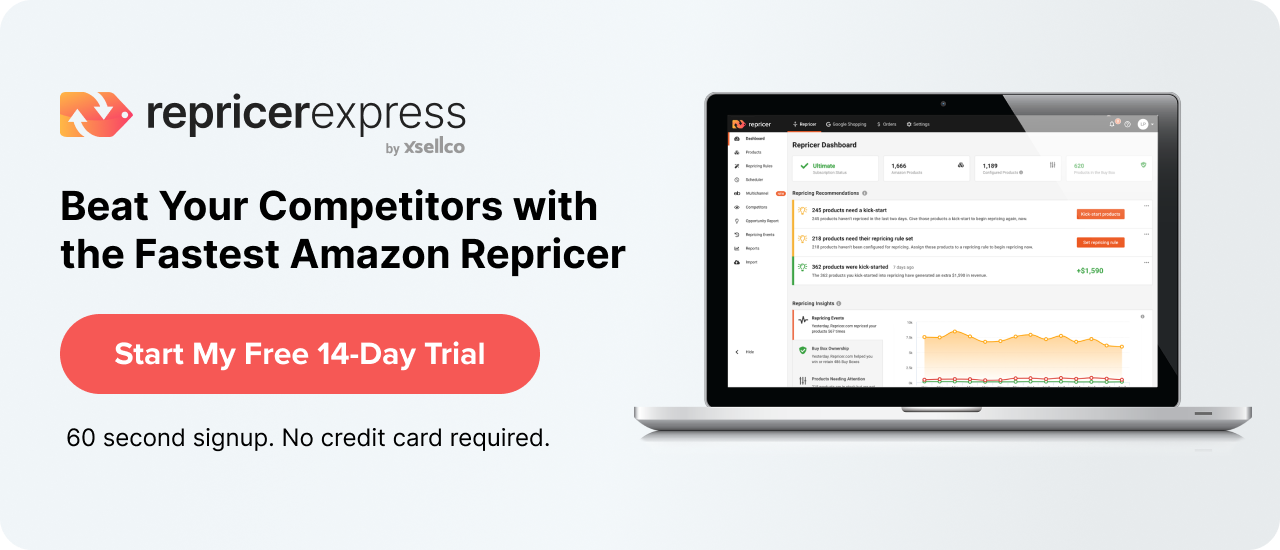If there was one universal pricing strategy, selling online would be really simple. All you’d have to do is learn that single rule and never deviate from it. But thanks to multiple selling platforms and marketplaces, there are various algorithms that dictate different pricing strategies. When it comes to repricing strategies for Shopify, RepricerExpress has you covered.
First, Master Your Expenses to Understand Which Shopify Pricing Strategy is Right for You
Before you get started with applying repricing strategies, you’ll have to have a thorough understanding of your revenue and expenses. If you don’t, you might as well take out a million-dollar mortgage on a double-digit salary.
Luckily, there are only a few factors to consider.
- Products: You’ll want to account for all costs that have to do with your products, starting with how much you pay per piece from the manufacturer or supplier to how much you pay to ship that product to you and then to a warehouse or fulfilment centre.
- Shopify Fees: Selling on Shopify isn’t free, so make a spreadsheet of what your varying, monthly and yearly expenses are, like store fees, developer fees, plugin fees and more.
- Fulfilment: Whether you handle 90% of fulfilment alone or pay someone to do it for you, make sure you have those numbers in black and white when determining which Shopify repricing strategy is best for you.
- Miscellaneous: These costs include things like domain costs, marketing and advertising costs, storage costs, staff salaries, hardware and software, and anything else you put into your Shopify store to keep it running.
Without a profitable Shopify pricing strategy, you could end up losing money.
Strategy 1: Pricing for a Premium Allure
Starbucks is one store that does premium pricing excellently. Their coffee is certainly not the best in the world, but they price it as though it is. And people willingly pay it. Why? Because they tend to equate higher prices with higher quality.
However, this repricing strategy can come with a drawback: you risk turning away customers who don’t think the value equals the price. If that happens, they’ll likely turn to your competitor, who offers lower prices.
Strategy 2: Pricing Dynamically
The opposite strategy of premium pricing is dynamic pricing, which means whatever prices your competitors set, you go a bit below. This repricing strategy attracts buyers looking for a deal and tends to result in high acquisition and conversion rates.
But if not carried out carefully and properly, dynamic repricing ends up in a race to the bottom. How low are you willing to price your products before it negatively affects your brand and profit margin?
Another factor to watch out for is having buyers equate low prices with cheap quality. Nobody shops at the dollar store expecting products to last for years, they shop there because it’s cheap. Do you want a dollar store reputation?
Strategy 3: Price Matching
Living in a sort of middle zone between these first two repricing strategies is price matching, where you offer buyers your competitors’ prices if they purchase from you (or even refunding the difference if they find a cheaper version of the same product).
The biggest benefit of this repricing strategy is reducing risk for conservative shoppers, but you’ll have to think carefully if your profit margins can handle this. You’ll want to be competitive, but not at the cost of offering expensive products for cheap, profit-cutting prices.
Strategy 4: Pricing the Same as the Manufacturer
If you want a simple repricing strategy for Shopify, using the manufacturer’s suggested retail price (MSRP) is the way to go. It requires no thought or deliberation, as all you have to do is use the price manufacturers have set out.
Arizona Iced Tea is a great example of this, as their price is printed right on their cans and buyers flock to this brand because they know the price is the same no matter where they buy it. But if you choose this pricing strategy, make sure to come up with other ways to differentiate yourself.
Strategy 5: Keystone Pricing
Another simple repricing strategy is keystone pricing, where you simply double your product’s wholesale price and use that as the retail price. It’s great because you can apply it to your inventory in one fell swoop, but the biggest risk is using keystone pricing on products that could end up comically overpriced when doubled.
Strategy 6: Marking Up Based on a Percentage
This strategy is also known as retail pricing and involves using a percentage to mark up your products’ prices. It requires a bit more math than keystone pricing because instead of straight doubling, you’re applying a specific percentage; that percentage may also differ based on which products you’re working with. You’ll have a lot of control over the final price but knowing what percentage to mark up is often the difference-maker.
Strategy 7: Repricing Based on Psychology
This one could require the most work of all the repricing strategies listed here but could also result in the most profit. There are many different forms of psychological pricing, so research each one carefully before applying them.
We can’t stress enough the importance of researching each method carefully, as using the wrong one (or the right one at the wrong time) can easily end up in buyers feeling manipulated and walking away. And if that happens, you’re risking your brand’s reputation in what could have been an easily avoided step.
Final Thoughts
Using any of these repricing strategies for Shopify is something you should be actively thinking about for the coming year, especially if you’re ready to take the next step and scale-up.
And if you’re not selling on Shopify but selling instead on Amazon or eBay, then you need to be using RepricerExpress, new year or not. If you’re not already on there, you’re losing valuable profits each hour you’re mulling over whether to sign up or not.
And if you need more time to think things over, our free 15-day trial gives you all the time you need to learn which features and benefits will work best for you.
Related: 5 Top Ecommerce Pricing Strategies Your Competitors Don’t Know About






